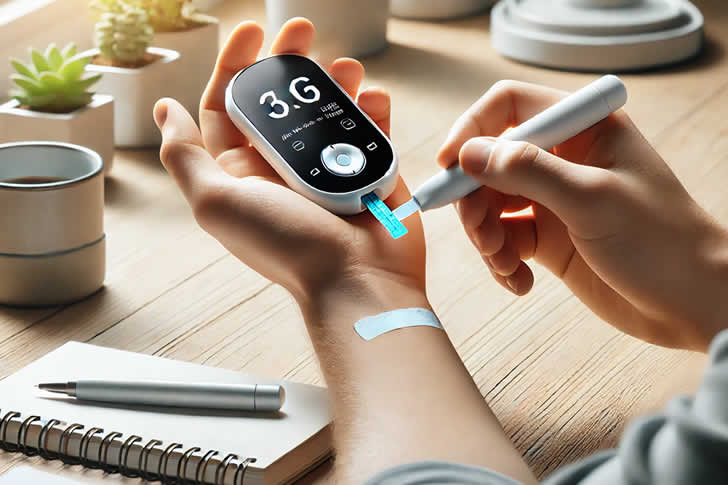All You Need to Know About The New Needleless Glucose Monitor And How to Get It
Monitoring blood sugar levels is essential for managing diabetes, but traditional finger-prick tests can be inconvenient and painful. The new needleless glucose monitors offer a non-invasive and more comfortable alternative for patients, revolutionizing diabetes care.

What is a Needleless Glucose Monitor?
A needleless glucose monitor is a non-invasive device that tracks your blood sugar levels without the need for finger pricks. These devices use advanced technology like sensors and optical systems to measure glucose levels through the skin or interstitial fluid. This development makes diabetes management simpler, more comfortable, and more consistent.
How Do They Work?
These monitors often use sensors applied to the skin or near the interstitial fluid. Some common technologies include:
- Optical Measurement: Using light waves to detect glucose levels under the skin.
- Intermittent Scanning: Scanning devices on-demand without pricking fingers.
- Wireless Connectivity: Data is often sent to a smartphone app for easy tracking and management.
Pros and Cons of Needleless Glucose Monitors
When considering switching to a needleless glucose monitor, there are several pros and cons to weigh:
Pros:
- Pain-Free: No need for daily finger pricks, which can be painful and inconvenient.
- Continuous Monitoring: Provides data in real-time, making it easier to track changes in blood sugar throughout the day.
- Easy to Use: Most devices are designed for simplicity, making them suitable for a wide range of users.
- Improved Accuracy: More frequent monitoring leads to better diabetes management and fewer complications.
Cons:
- Cost: Needleless glucose monitors are more expensive than traditional monitors and require recurring purchases of sensors or patches.
- Calibration: Some devices may require occasional calibration, which could be an inconvenience.
- Learning Curve: There may be a period of adjustment when transitioning to a new device.
Types of Needleless Glucose Monitors
There are a variety of needleless glucose monitors available on the market, each offering distinct features.
- Freestyle Libre: A popular sensor-based system providing continuous monitoring.
- Eversense CGM: An implantable sensor with long-term data gathering capabilities.
- SugarBEAT: A skin-worn patch that measures glucose levels through the skin.
- Dexcom G6: A trusted monitor that provides real-time glucose readings.
- GlucoTrack: A non-invasive device that uses ultrasonic, electromagnetic, and thermal technologies.
- K’Watch Glucose: A smartwatch-style glucose monitor that tracks glucose levels without pricking.
- Symphony tCGM: Uses a biosensor applied to the skin, offering continuous readings.
- Nemaura SugarBEAT: A needle-free glucose patch that transmits data to a connected app.
- Sensionics Implantable CGM: An implantable sensor offering 90-day monitoring without finger sticks.
- GlucoWise: A non-invasive monitor that tracks glucose levels in real-time through the skin.
How to Get a Needleless Glucose Monitor
If you’re interested in purchasing a needleless glucose monitor, you can find them through various online retailers or local pharmacies. Many brands are also available directly from the manufacturer. Some devices may require a prescription, so check with your healthcare provider before making a purchase.
Common Costs of Needleless Glucose Monitors
The cost of needleless glucose monitors can vary depending on the brand, technology, and additional features like connectivity or data storage. Here’s a breakdown of the pricing of different monitors across the U.S.:
| City | Monitor Name | Price Range | Highlights | Benefits | Suitable Audiences |
|---|---|---|---|---|---|
| New York, NY | Freestyle Libre | $100 – $200 | 14-day wear sensor | Affordable, easy to use | Type 1 & Type 2 diabetes patients |
| Los Angeles, CA | Dexcom G6 | $300 – $450 | Continuous glucose monitoring | Real-time alerts | Patients needing real-time data |
| Chicago, IL | Eversense CGM | $600 – $850 | Implantable for 90 days | Long-lasting, high precision | Type 1 diabetics |
| Houston, TX | GlucoTrack | $150 – $300 | Non-invasive measurement | No pricks, user-friendly | Non-insulin dependent diabetics |
| Phoenix, AZ | SugarBEAT | $250 – $400 | Adhesive patch for daily use | Reusable patches | Adults with Type 2 diabetes |
| Philadelphia, PA | Nemaura SugarBEAT | $200 – $350 | Flexible usage options | Painless and easy to wear | Type 2 diabetic patients |
| Miami, FL | K’Watch Glucose | $300 – $500 | Smartwatch form factor | Stylish and convenient | Active users |
| Denver, CO | Symphony tCGM | $350 – $500 | Biosensor applied to the skin | Non-invasive continuous monitoring | Elderly patients |
| Seattle, WA | GlucoWise | $200 – $400 | Tracks glucose through the skin | No implants or pricks | Non-insulin-dependent diabetics |
| Atlanta, GA | Sensionics Implantable CGM | $600 – $850 | Implantable, long-term monitoring | High accuracy, fewer changes | Patients requiring consistent monitoring |
Q&A Section
Q: How does a needleless glucose monitor compare to traditional finger-prick devices?
A: Needleless monitors provide continuous glucose monitoring without the need for finger pricks. They are generally more convenient, though they tend to be more expensive.
Q: Are needleless glucose monitors covered by insurance?
A: Some insurance providers cover these monitors, but coverage varies depending on the brand and plan. It’s important to check with your provider for specific details.
Q: How long do sensors or patches last?
A: Sensor life varies by brand. For example, Freestyle Libre sensors last 14 days, while Eversense’s implantable sensor can last up to 90 days.
Conclusion
Needleless glucose monitors are a game-changer for diabetes management, offering a more comfortable, less invasive way to monitor blood sugar levels. Whether you’re looking for a basic model or an advanced continuous glucose monitor, there’s an option for every need and budget. Consult with your healthcare provider to determine which device is best for you, and take advantage of this innovative technology to improve your diabetes care.
Citations:







Recent Comments